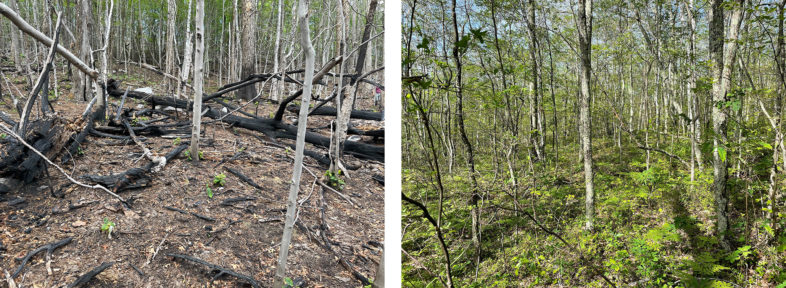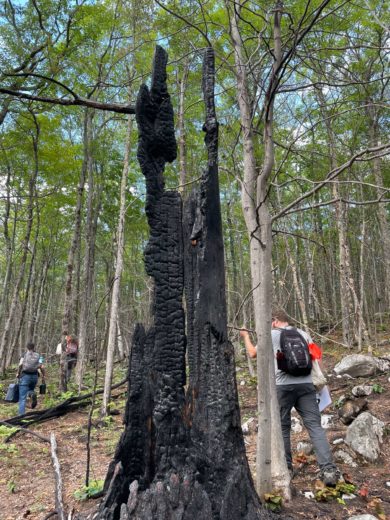
The west side of the Dome trail shows evidence of previous prescribed burns used to manage forest structure (left). The east side of the trail where prescribed burns have never been used (right). © Ryan Rebozo (both)
This past summer, I teamed up with Dr. Jay Kelly and Jessica Ray from Raritan Valley Community College (RVCC) on a new project studying the efficacy of fire as a management tool in Vermont’s uncommon (S3) dry oak forests. Our work focuses primarily on the “Dome,” a site in the Green Mountain National Forest (GMNF) where over 280 acres of dry oak habitat can be found. While lugging our field equipment up the Dome trail during our first visit, we noticed charred vegetation on the west side, indicating where fire was used. In contrast, the unmanaged east side of the trail had a more lush, herbaceous understory. Forest managers have used prescribed burns on approximately half of the Dome to prevent a shift in tree species composition and maintain this area as red oak dominated. Our project aims to help our GMNF partners better understand how prescribed burns can be used to help retain these oak-dominated forests and account for rare plant and insect species that may also utilize this habitat.
Wildfires are rare in Vermont; however, you can find evidence of areas adapted to fire by looking at plants and their growing conditions. For example, as I dug through the leaf litter to collect samples, I made it down to sandy soils close to bedrock that maintain the site’s dry conditions. Our surveys also documented many understory plants in the heath family (such as blueberries and huckleberries) that are particularly fire-adapted, suggesting fire may have historically played a role in shaping the area’s plant species composition. As time passes since an area last burned, local species composition grows increasingly dominated by shade-tolerant plants, which promote shady, damp conditions that reduce fire risk in the future. This positive feedback loop characterized by a proliferation of shade-tolerant species is known as mesophication.

The team moves through one of the Dome’s previously burned areas. © Ryan Rebozo
In recent years, Vermont land managers’ interest in using prescribed fire to address mesophication (among other objectives) in oak forests has grown. Yet, fire’s use as a management tool is more complicated than one might expect. Ecologists suspect that prescribed burning benefits oaks’ regeneration by reducing competition, litter depth, or seed predation and increasing light and nutrient availability. However, the benefits of fire for oaks and other hardwoods are highly variable—outcomes depend on factors such as initial site conditions, species, timing, and size class structure. Pressure from invasive species and local deer densities may further complicate oak and other hardwood species’ ability to regrow in burned areas.
To assess how dry oak habitats at the Dome are responding to prescribed fire and provide data that can help inform future management practices, Dr. Kelly, Jessica, a team of RVCC interns, and I began collecting data on both burned and unburned portions of this site. We scoured the forest from top to bottom, documenting everything from canopy trees and cover down to litter depth and duff layers. In between, we recorded herbaceous plant and shrub species, tree regeneration, and signs of herbivory. To complement our observations, we used ground-based LiDAR to thoroughly scan forest structure at each sampling location to compare management strategies further. By using Forest Service-approved methodology, we also ensure that future monitoring efforts can compare their results to our data.
Stay tuned for an update in early spring after we conduct infrared deer surveys using a drone to quantify deer densities.

Have lived and owned current use land in VT for 32 years. Please no prescribed burns! Even though I trust the forest service here more than out West. I grew up out West and just left New Mexico last March when the prescribed state approved burn got out of control. Poor New Mexico. We have to be so careful with prescribed burning!!!
Native Americans used prescribed burns for hundreds, if not thousands of years before European or Chinese exploration of this area. The Europeans five new England in a state similar to a park, limited underbrush, massive hurds of wild animals, and beautiful. it wasn’t until they set up settlements that they started to complain about and limit the practice. let’s push the carbon back into the ground, return to a Native American type environment, and manage the impact of first fires using this time tested and effective land management program. Embrace the prescriptive burning practice that limited species creep, controlled the insect populations, and made our forests healthy and safe again
*hundreds, if not,